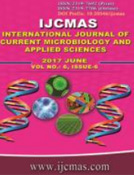


 National Academy of Agricultural Sciences (NAAS)
National Academy of Agricultural Sciences (NAAS)

|
PRINT ISSN : 2319-7692
Online ISSN : 2319-7706 Issues : 12 per year Publisher : Excellent Publishers Email : editorijcmas@gmail.com / submit@ijcmas.com Editor-in-chief: Dr.M.Prakash Index Copernicus ICV 2018: 95.39 NAAS RATING 2020: 5.38 |
Urinary tract infection (UTI) includes the infection of urethra, bladder, ureters and kidneys which comprise the urinary tract. UTI is an important cause of morbidity and mortality in both developing and developed countries of the world. Urine samples were collected from In-patients and Out-patients attending hospital with the history suggestive of Urinary Tract Infection. Clean catch mid-stream urine samples were collected in sterile universal containers after proper cleansing of urethra and perineum. 1200 samples were collected from IP/OP patients. The sample size was higher in number because we got more samples than what are expected approximately for two months while starting the study. These samples were processed within 2 hours of collection without delay. A total no of 1,200 samples were collected from in-patient and Out-patient departments of the tertiary care hospital. Out of these 1,200 samples significant bacteriuria (30%) was observed in 354 samples. Out of these 354 isolates, 63(10.1%) isolates were found to be Gram positive cocci, 290(81.9%) were Gram negative bacilli and 1(0.2%) fungi-Candida spp. Among total 290 GNB isolates E. coli 146(41.2%), Klebsiella pneumoniae 81(22.8 %), Klebsiella oxytoca 15 (4.2%), Pseudomonas aeruginosa 20(5.6%), Proteus spp 10(2.8%), Acinetobacter spp 8(2.2%), Citrobacter spp 6(1.6%), Morganella spp 3(1%), and Providencia spp 1(0.2%) were isolated. Among the total GPC isolates Staphylococcus aureus 8(2.2%), CONS 54(15.2%) and Enterococcus spp 1(0.2%) were isolated. ESBLs are now causing the major threatening infections in hospitalized patients throughout the world. The prevalence of ESBLs among clinical isolates varies greatly in worldwide. Major risk factors for colonization of ESBLs are long term antibiotic therapy, prolonged hospital stay and H/O instrumentation or catheterization. In India the prevalence of ESBL production varies from 10% to 84%. Cefoperazone/Sulbactum 98.5 % and Piperacillin/Tazobactum 97% are very effective in treatment of ESBL producing organism associated urinary tract infection. Amikacin, Nitrofurantoin followed by Gentamicin are showed higher susceptibility rate when compared to other drugs and these can be used as I line empirical drugs in UTI according to the patient’s renal condition.
 |
 |
 |
 |
 |